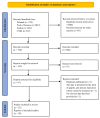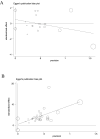Short-term Effects of High Thoracic Epidural Blockade in Patients With Ischemic Heart Disease and Heart Failure: A Systematic Review and Data Synthesis
- PMID: 40776935
- PMCID: PMC12326434
- DOI: 10.31083/RCM37886
Short-term Effects of High Thoracic Epidural Blockade in Patients With Ischemic Heart Disease and Heart Failure: A Systematic Review and Data Synthesis
Abstract
Background: High thoracic epidural blockade (HTEB) with local anti-sympathetic effects modulates cardiac performance in patients undergoing cardiac or non-cardiac surgeries. However, the short-term cardio-protective effects of HTEB in non-operative patients with ischemic heart disease (IHD) and heart failure (HF) remain unclear. Our study aimed to pool evidence regarding the benefits of adjunctive HTEB intervention in patients with IHD and HF.
Methods: Exposures were defined as non-operative patients with IHD and HF who received adjunctive HTEB intervention and/or conventional medical treatment (CMT). The primary outcomes were clinical recovery indicator assessments, electrocardiographic and ultrasonic index improvement, laboratory tests, and hemodynamic benefits provided by adjunctive HTEB treatment. The secondary outcome was the effectiveness rate and adverse side effects after HTEB intervention. The pooled analyses of continuous variables were conducted using a fixed-effects model and the effects were represented by the weighted mean difference (WMD) and a 95% confidence interval (CI). The effective rates of HTEB treatment were represented using odds ratios (ORs, 95% CI) or effect size (ES, 95% CI). The I2 statistic was used to identify any inconsistency in the pooled results from individual trials. A meta-regression and subgroup analysis were conducted when inconsistencies in individual trials were detected.
Results: HTEB treatment was associated with a significant 10% increase in left ventricular ejection fraction (summary WMD, 9.651 [95% CI: 9.082 to 10.220]), a decline in neuroendocrine hormone levels, myocardial ischemia relief, improvement in hemodynamics, and the reversal of decompensated cardiac remodeling. HTEB treatment is more effective than conventional medical treatment (odds ratio, 5.114 [95% CI: 3.189 to 8.203]) in treating HF and angina pectoris.
Conclusions: Our results suggest that HTEB intervention may be a complementary approach for cardiac rehabilitation in patients with IHD and HF. However, more data are necessary to confirm these findings due to the significant heterogeneity of the included studies.
Keywords: heart failure; high thoracic epidural blockade; ischemic heart disease; systematic review.
Copyright: © 2025 The Author(s). Published by IMR Press.
Conflict of interest statement
The authors declare no conflict of interest.
Figures


Similar articles
-
Beta-blockers in patients without heart failure after myocardial infarction.Cochrane Database Syst Rev. 2021 Nov 5;11(11):CD012565. doi: 10.1002/14651858.CD012565.pub2. Cochrane Database Syst Rev. 2021. PMID: 34739733 Free PMC article.
-
Drugs for preventing postoperative nausea and vomiting in adults after general anaesthesia: a network meta-analysis.Cochrane Database Syst Rev. 2020 Oct 19;10(10):CD012859. doi: 10.1002/14651858.CD012859.pub2. Cochrane Database Syst Rev. 2020. PMID: 33075160 Free PMC article.
-
Epidural versus non-epidural or no analgesia for pain management in labour.Cochrane Database Syst Rev. 2018 May 21;5(5):CD000331. doi: 10.1002/14651858.CD000331.pub4. Cochrane Database Syst Rev. 2018. PMID: 29781504 Free PMC article.
-
Intravenous magnesium sulphate and sotalol for prevention of atrial fibrillation after coronary artery bypass surgery: a systematic review and economic evaluation.Health Technol Assess. 2008 Jun;12(28):iii-iv, ix-95. doi: 10.3310/hta12280. Health Technol Assess. 2008. PMID: 18547499
-
Systemic pharmacological treatments for chronic plaque psoriasis: a network meta-analysis.Cochrane Database Syst Rev. 2017 Dec 22;12(12):CD011535. doi: 10.1002/14651858.CD011535.pub2. Cochrane Database Syst Rev. 2017. Update in: Cochrane Database Syst Rev. 2020 Jan 9;1:CD011535. doi: 10.1002/14651858.CD011535.pub3. PMID: 29271481 Free PMC article. Updated.
References
-
- Ambrosy AP, Fonarow GC, Butler J, Chioncel O, Greene SJ, Vaduganathan M, et al. The global health and economic burden of hospitalizations for heart failure: lessons learned from hospitalized heart failure registries. Journal of the American College of Cardiology . 2014;63:1123–1133. doi: 10.1016/j.jacc.2013.11.053. - DOI - PubMed
-
- Wang H, Li Y, Chai K, Long Z, Yang Z, Du M, et al. Mortality in patients admitted to hospital with heart failure in China: a nationwide Cardiovascular Association Database–Heart Failure Centre Registry cohort study. The Lancet. Global Health . 2024;12:e611–e622. doi: 10.1016/S2214-109X(23)00605-8. - DOI - PubMed
-
- Authors/Task Force Members, McDonagh TA, Metra M, Adamo M, Gardner RS, Baumbach A, et al. 2021 ESC Guidelines for the diagnosis and treatment of acute and chronic heart failure: Developed by the Task Force for the diagnosis and treatment of acute and chronic heart failure of the European Society of Cardiology (ESC). With the special contribution of the Heart Failure Association (HFA) of the ESC. European Journal of Heart Failure . 2022;24:4–131. doi: 10.1002/ejhf.2333. - DOI - PubMed
Publication types
LinkOut - more resources
Full Text Sources
Research Materials
Miscellaneous

